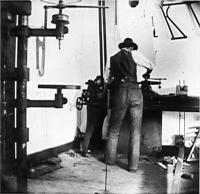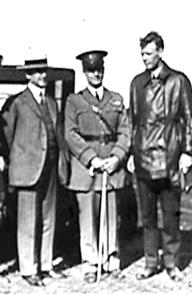


|
In 1892, the Wright brothers also became bicycle manufacturers to capitalize on the bicycle "craze" sweeping the nation. They began building, racing and repairing bicycles. Their company produced three models - the "Van Cleve" named after their pioneer ancestors, later the "St. Clair", and finally, some say they had a low-priced model known as the "Wright Special".
The Wright brothers had two older brothers, Reuchlin and Lorin, and a younger sister, Katharine. None of the Wright children were given middle names. Wilbur and Orville were named after churchmen. Their father, Milton, was a Bishop in the church and his wife, Susan, was a well-educated woman. It was she who stimulated the Wright Brothers interest in mechanical things and (unbeknownst to him), let them use their father's good tools.

|
The 1903 Wright Flyer had the same general design as their third glider -- elevator out front; operator, engine, and props between two forty-foot wings; and double rudder now pushed far enough behind to suggest the appearance of a tail. When assembled at the Wright's shack on the barren Carolina dunes, the machine rested on skids. In launching the airplane, the brothers planned to set these skids on a yoke on two small wheels that ran along a sixty-foot rail pointed into the wind. One brother would keep the craft tethered while the other, poised with his cap reversed, ran up the engine. Then the one whose turn it was to stay on the ground would release the machine and run alongside holding a wingtip until the plane got up speed. In the strong Hatteras winds it would then rise from the yoke and fly. The weight of their contraption was 605 pounds -- this compares with the 574 pounds of the Piper Cub.
Who created the first "stealth" aircraft? Believe it or not, it was the Wright brothers! In 1909, they were asked to fly demonstrations for the military. By this time, they were very careful at displaying their aircraft, as everyone wanted to copy their designs. So before the military demonstration, they varnished the aircraft and while it was still wet, covered it with aluminum powder. When the photographs were developed, it was very hard to see any details, as this "gray" airplane tended to blend into the background.
The great inventions of the Wright brothers included

Despite the financial burdens of all their research, testing and many aircraft built, the Wright Brothers were never financed by outsiders. The bicycle was a hot item at that time, and their bicycle shop financed everything. Their father gave them one thousand dollars each in the beginning, but they invested it wisely, and had they ever needed funding, it was there, but it was never touched.
The Wrights, along with other early experimentors with model machines, unhappily discovered that when the linear measurements of a model were doubled, it needed about eight times the power to fly.
 Orville Wright with Maj. John Curry and Col. Charles Lindbergh at Wright Field, Dayton, June 22, 1927 |
The first passenger to ever fly in an aeroplane was Charles W. Furnas who was taken aloft by Wilbur Wright on May 14, 1908 for a flight covering 1,968 ft, of 28.6 seconds duration. Later the same morning, Orville Wright flew Furnas for a distance of about 2.5 miles, which was covered in 3 minutes and 40 seconds.
Orville and Wilbur flew together only once in their aeroplane for their father to see, but decided it unwise, because if they crashed, no one could carry on their work.
The Wright Brothers inherited an aptitude for independent judgment, personal courage and mechanical talents of superior calibre. Two older brothers, Reuchlin and Lorin and a sister Katharine, went on to college, while Orville and Wilbur had only high school educations, and never officially graduated. However, their solid scientific methods had set free the ancient dream of human flight. The first American to fly after the Wright Brothers was Glenn H. Curtiss, who flew his "June Bug" for the first time on June 20, 1908.
The first aeroplane purchased by the American Government was a Wright Biplane, "Miss Columbia", sold by the Wright Brothers on July 30, 1909. The price was $25,000, but a bonus of $5,000 was awarded because the specified maximum speed of 40mph was exceeded. The aircraft was constructed in Dayton, Ohio.
The first aeroplane armed with a machine gun was a Wright Biplane flown by Lt. Thomas de Witte at College Park, Maryland on May 7, 1912. The gunner, who was armed with a Lewis gun, was Charles de Forest Chandler of the U. S. Army Signal Corps.
The first Air Service of the U. S. Army was established on July 18, 1914, when an aviation section was formed as part of the Signal Corps with a "paper" strength of 60 officers and 260 men. The entire fleet amounted to six aeroplanes.
For additional background on the Wright Brothers, please visit
these sites
Copyright © 1996-2003, AIAA Wright Flyer Project, all rights reserved.